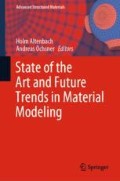Abstract
We study deformation and fracture of a brittle material under mixed quasi-static loading. Numerical simulations of deformation of a cubic sample containing a single crack are carried out using the particle dynamics method. Effect of ratio of compressive and shear loads on energy of fracture initiation is investigated for two crack shapes and various crack orientations. The energy of fracture initiation in a material containing multiple cracks is estimated using the non-interaction approximation. It is shown that in the case of mixed loading (compression and shear) the energy is significantly lower than in the case of pure compression. Presented results may serve for minimization of energy consumption during disintegration of solid minerals.
Access this chapter
Tax calculation will be finalised at checkout
Purchases are for personal use only
Preview
Unable to display preview. Download preview PDF.
References
Altenbach H, Öchsner A (eds) (2011) Cellular and Porous Materials in Structures and Processes, CISM International Centre for Mechanical Sciences, vol 521. Springer, Vienna
Altenbach H, Sadowski T (eds) (2015) Failure and Damage Analysis of Advanced Materials, CISM International Centre for Mechanical Sciences, vol 560. Springer, Vienna
Bîrsan M, Altenbach H (2011) On the theory of porous elastic rods. International Journal of Solids and Structures 48(6):910 – 924
Bratov VA, Krivtsov AM (2016) Analysis of energy required for initiation of inclined crack under
uniaxial compression and mixed loading. Engineering Fracture Mechanics 219:106,518
Grechka V, Kachanov M (2006) Effective elasticity of rocks with closely spaced and intersecting cracks. GEOPHYSICS 71(3):D85–D91
Jaworski D, Linkov A, Rybarska-Rusinek L (2016) On solving 3d elasticity problems for inhomoge- neous region with cracks, pores and inclusions. Computers and Geotechnics 71(6):295–309
Kachanov M (1999) Solids with cracks and non-spherical pores: proper parameters of defect density and effective elastic properties. International Journal of Fracture 97(1-4):1 – 32
Kachanov M, Sevostianov I (2005) On quantitative characterization of microstructures and effective properties. International Journal of Solids and Structures 42(2):309 – 336
Kachanov M, Sevostianov I (2018) Micromechanics of Materials, with Applications, Solid Mechanics and Its Applications, vol 249. Springer
Krivtsov AM (2003) Molecular dynamics simulation of impact fracture in polycrystalline materials. Meccanica 38(01):61–70
Krivtsov AM (2004) Molecular dynamics simulation of plastic effects upon spalling. Physics of the Solid State 46(6):1055–1060
Krivtsov AM (2007) Deformation and Fracture of Solids with a Microstructure (in Russ.). Fizmatlit, Moscow
Kumar M, Han D (2005) Pore shape effect on elastic properties of carbonate rocks, Society of Exploration Geophysicists, pp 1477–1480
Kuna M (2013) Finite Elements in Fracture Mechanics, Solid Mechanics and Its Applications, vol 213. Springer Netherlands
Kushch VI, Sevostianov I, Mishnaevsky L (2009) Effect of crack orientation statistics on effective stiffness of mircocracked solid. International Journal of Solids and Structures 46(6):1574 – 1588
Linkov AM (2002) Boundary Integral Equations in Elasticity Theory. Kluwer Academic Publishers, Dordrecht-Boston-London
Min KB, Jing L (2003) Numerical determination of the equivalent elastic compliance tensor for fractured rock masses using the distinct element method. International Journal of Rock Mechanics and Mining Sciences 40(6):795 – 816
Novozhilov VV (1969) On a necessary and sufficient criterion for brittle strength. Journal of Applied Mathematics and Mechanics 33(2):201 – 210
Rejwer E, Rybarska-Rusinek L, Linkov A (2014) The complex variable fast multipole boundary element method for the analysis of strongly inhomogeneous media. Engineering Analysis with Boundary Elements 43:105–116
Saenger EH (2008) Numerical methods to determine effective elastic properties. International Journal of Engineering Science 46(6):598 – 605
Sayers CM, Kachanov M (1991) A simple technique for finding effective elastic constants of cracked solids for arbitrary crack orientation statistics. International Journal of Solids and Structures 27(6):671 – 680
Shafiro B, Kachanov M (1997) Materials with fluid-filled pores of various shapes: Effective elastic properties and fluid pressure polarization. International Journal of Solids and Structures 34(27):3517 – 3540
Shafiro B, Kachanov M (2000) Anisotropic effective conductivity of materials with nonrandomly oriented inclusions of diverse ellipsoidal shapes. Journal of Applied Physics 87(12):8561–8569
Torquato S (1991) Random heterogeneous media: microstructure and improved bounds on effective properties. Applied Mechanics Reviews 44(2):37–76
Tsaplin VA, Kuzkin VA (2017) On using quasi-random lattices for simulation of isotropic materials. Materials Physics and Mechanics 32(12):321–327
Vaisberg LA, Kameneva EE (2014) X-ray computed tomography in the study of physico-mechanical properties of rocks. Gornyi Zhurnal 9:85–90
Vaisberg LA, Baldaeva TM, Ivanov TM, Otroshchenko AA (2016) Screening efficiency with circular and rectilinear vibrations. Obogashchenie Rud 1:1–12
Vaisberg LA, Kameneva EE, Nikiforova VS (2018a) Microtomographic studies of rock pore space as the basis for rock disintegration technology improvements. Obogashchenie Rud 3:51–55
Vaisberg LA, Kruppa PI, Baranov VF (2018b) Microtomographic studies of rock pore space as the
basis for rock disintegration technology improvements. Obogashchenie Rud 3:51–55
Vesga LF, Vallejo LE, Lobo-Guerrero S (2008) DEM analysis of the crack propagation in brittle clays under uniaxial compression tests. International Journal for Numerical and Analytical Methods in Geomechanics 32(11):1405–1415
Acknowledgements
This work was supported by the Russian Science Foundation (Grant No. 17-79-30056). The authors are deeply grateful L.A Vaisberg for formulation of the problem and useful discussions. The work was initiated in the course of joint investigation of technological processes of vibration disintegration of materials, the main developer of which is REC “Mekhanobr-Tekhnika”. Numerical modeling was performed using the Polytechnic supercomputer center at Peter the Great St. Petersburg Polytechnic University.
Author information
Authors and Affiliations
Corresponding author
Editor information
Editors and Affiliations
Rights and permissions
Copyright information
© 2019 Springer Nature Switzerland AG
About this chapter
Cite this chapter
Lapin, R.L., Muschak, N.D., Tsaplin, V.A., Kuzkin, V.V., Krivtsov, A.M. (2019). Estimation of Energy of Fracture Initiation in Brittle Materials with Cracks. In: Altenbach, H., Öchsner, A. (eds) State of the Art and Future Trends in Material Modeling . Advanced Structured Materials, vol 100. Springer, Cham. https://doi.org/10.1007/978-3-030-30355-6_8
Download citation
DOI: https://doi.org/10.1007/978-3-030-30355-6_8
Published:
Publisher Name: Springer, Cham
Print ISBN: 978-3-030-30354-9
Online ISBN: 978-3-030-30355-6
eBook Packages: Chemistry and Materials ScienceChemistry and Material Science (R0)

